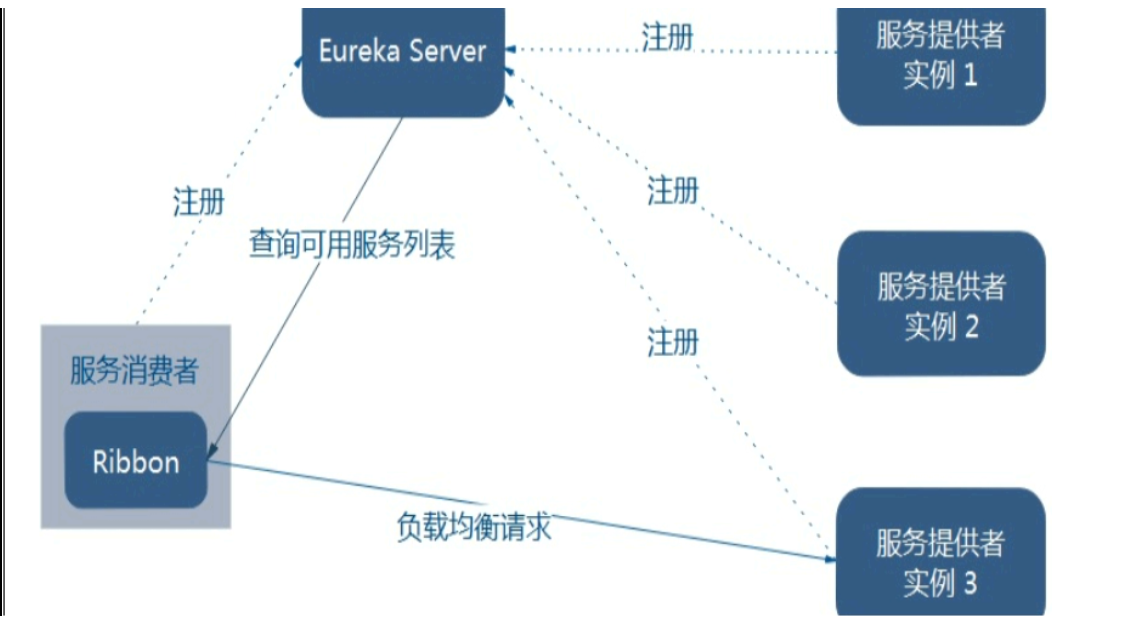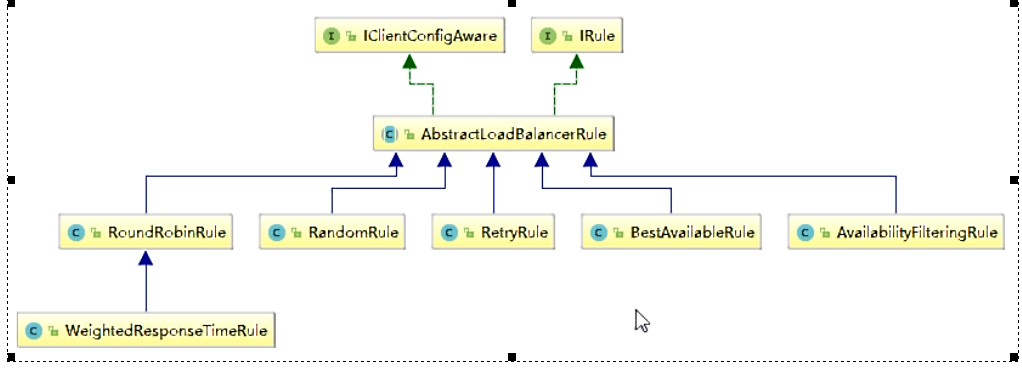一、Ribbon概述
SpringCloud Ribbon 是基于Netflix Ribbon实现的一套客户端,负载均衡的工具。
简单的说,Ribbon是Netflix发布的开源项目,主要功能是提供客户端的软件负载均衡算法和服务调用,Ribbon客户端组件提供一系列完善的配置项如连接超时,重试等,简单的说,就是配置文件中列出Load Banlancer (简称LB) 后面所有的机器,Ribbon都会自动的帮助你基于某种规则(如简单轮询,随机连接等)去连接这些机器。我们很容易使用Ribbon实现自定义的负载均衡算法。
官网: https://github.com/Netflix/ribbon/wiki/Getting-Started
Ribbon已经进入维护模式!未来的替换方案:Load Banlancer
1、Ribbon能作什么
1.1 LB (负载均衡)
LB 负载均衡 Load balance 是什么
简单的说就是将用户的请求平摊的分配到多个服务上,从而达到系统的HA(高可用)
常见的负载均衡有软件 Nginx LVS 硬件F5等
Ribbon本地负载均衡客户端VS Nginx 服务端负载均衡区别
Nginx是服务器负载均衡,客户端所有请求都会交给Nginx,然后由Nginx实现转发请求,即负载均衡是由服务端实现的
Ribbon 本地负载均衡,再调用微服务接口时候,会在注册中心上获取注册信息服务列表之后缓存到JVM本地,从而在本地实现RPC远程服务调用技术
1.2 集中式 LB
- 集中式LB:即在服务的消费方和提供方之间使用独立的LB设施(可以是硬件,如F5,也可以是软件,如Nginx),由该设施负责把访问请求通过某种策略转发至服务的提供方。
1.3 进程内 LB
- 将LB逻辑集成到消费方,消费方从服务注册中心或知有哪些地址可用,然后自己再从这些地址中选择出一个何时的服务器。
- Ribbon就属于是进程内LB, 它只是一个类库,集成与消费方进程,消费方通过它来获取到服务提供方的地址。
2、注意事项
如果配置文件中配置instace-id时 启动多个实例 注意修改id的值
eureka:instance:instance-id: payment8002 # 这里的payment8002 如果要在启动一个的话 需要改成payment8003prefer-ip-address: true # 访问路径可以显示IP地址
3、负载均衡演示
3.1 架构说明
总结:Ribbon其实就是一个软负载均衡的客户端组件。
它可以和其他所需请求的客户端结合使用,和eureka结合只是其中一个实例

3.2 Ribbon在工作时分为两步:
- 第一步先选择EurekaServer,它优先选择在同一个区域内负载较少的server
- 第二部再根据用户指定的策略,再从server取到的服务注册列表中选择一个地址。
其中Ribbon提供了多种策略:比如 轮询,随机和根据响应时间加权。
4、依赖
Eureka Client 会自己带着Ribbon 所以不需要添加Ribbon依赖
如果不放心 也可以自己添加【完全没必要加】
<dependency><groupId>org.springframework.cloud</groupId><artifactId>spring-cloud-starter-netflix-ribbon</artifactId></dependency>
5、二说RestTemplate
官网: https://docs.spring.io/spring-framework/docs/5.2.2.RELEASE/javadoc-api/org/springframework/web/client/RestTemplate.html
5.1 getForObject() 和 getForEntity()
getForObject()// 返回对象为响应体中数据转化成的对象,基本上可以理解为JSONgetForEntity()// 返回对象为ResponseEntity对象,包含了响应中的一些重要信息,比如响应头,响应状态码,响应体等。
------------------ getForObject() --------------------------------------@GetMapping(/consumer/payment/get/{id})public CommonResult<Payment> get Payment(@PathVariable("id") Long id){String url = "http://localhost:8001/payment/get/" + id;// 返回对象为响应体中数据转化成的对象,基本上可以理解为JSONreturn restTemplate.getForObject(url,CommonResult.class);}------------------ getForEntity() --------------------------------------@GetMapping("/consumer/payment/get/{id}")public CommonResult<Payment> get Payment(@PathVariable("id") Long id){String url = "http://localhost:8001/payment/get/" + id;// 返回对象为ResponseEntity对象,包含了响应中的一些重要信息,比如响应头,响应状态码,响应体等。ResponseEntity<CommonResult> responseEntity = restTemplate.getForEntity(url,CommontResult.class);// 判断是否成功if(responseEntity,getStatusCode.is2xxSuccessful()){return responseEntity.getBody();}else{return new CommonResult(444,"操作失败");}}
5.2 postForObject() 和 postForEntity()
@PostMapping("/consumer/payment/create")public CommonResult<Payment> create(@RequestBody Payment payment){String url = "http://localhost:8001/payment/create";// postForObject() 可以直接return回去return restTemplate.postForObject(url,payment,CommonResult.class);// postForEntity() 需要调用getBody() 在返回return restTemplate.postForEntity(url,payment,CommonResult.class).getBody;}
6、Ribbon核心组件IRule
6.1 IRule:根据特定算法从服务列表中选取一个要访问的服务
com.netflix.loadbalancer.RoundRobinRule:- 轮询
com.netflix.loadbalancer.RandomRule:- 随机
com.netflix.loadbalancer.RetryRule- 先按照RoundRobinRule的策略获取服务,如果获取服务失败则在指定时间内会进行重试
WeightedResponseTimeRule- 对RoundRobinRule的扩展,响应速度越快的实例选择权重越大,越容易被选择
BestAvailableRule- 会先过滤掉由于多次访问故障而处于断路器跳闸状态的服务,然后选择一个并发量最小的服务
AvailabilityFilteringRule- 先过滤掉故障实例,再选择并发较小的实例
ZoneAvoidanceRule- 默认规则,复合判断server所在区域的性能和server的可用性选择服务器
6.2 如何替换负载均衡算法
① 修改消费者服务 consumer
② 配置类
注意这个 自定义配置类不能放在@ComponentScan所扫描的当前包下以及子包 否则我们自定义的这个配置类旧会被所有的Ribbon客户端所共享,达不到特殊化定制的目的了。
主启动类:com.springcloud.主启动类
负载均衡算法包:com.myrule 在主启动类上一次,就不会被扫描到
@Configurationpublic class MySelfRule {@Beanpublic IRule iRule(){// 随机算法return new RandomRule();}}

③ 主启动类
消费者的主启动类**@RibbonClient(configuration = MySelfRule.class)**
@EnableEurekaClient@SpringBootApplication// name 写要负载均衡访问的provider的微服务名字@RibbonClient(name = "cloud-payment-service",configuration = MySelfRule.class)public class OrderMain80 {public static void main(String[] args) {SpringApplication.run(OrderMain80.class,args);}}
7、Ribbon负载均衡算法
7.1 原理
负载均衡算法:rest接口第几次请求数 % 服务器集群总数量 = 实际调用服务器位置下标,每次服务重启后rest接口计数从1开始。
List<ServiceInstance> instances = doscoveryClient.getInstances("cloud-payment-service");List[0] instances = 127.0.0.1:8002;List[1] instances = 127.0.0.1:8001;8001 + 8002 组合为集群,他们共计2台机器,集群总数为2,按照轮询算法原理:当总请求数为1时:1 % 2 = 1,对应下标为 1,则获得服务地址为 127.0.0.1:8001当总请求数为2时:2 % 2 = 0,对应下标为 0,则获得服务地址为 127.0.0.1:8002当总请求数为3时:3 % 2 = 1,对应下标为 1,则获得服务地址为 127.0.0.1:8001当总请求数为4时:4 % 2 = 0,对应下标为 0,则获得服务地址为 127.0.0.1:8002如此类推
7.2 手写规则
① 8001和8002微服务改造
@RequestMapping("/get/lb")public String getLBid(){return port;}
② 80消费者RestTemplate去掉@LoadBalanced
③ 创建服务接口
package com.springcloud.lb;import org.springframework.cloud.client.ServiceInstance;import java.util.List;/*** @date: 2021/4/6 18:44* @author: 易学习*/public interface LoadBalancer {//收集服务器总共有多少台能够提供服务的机器,并放到list里面ServiceInstance instances(List<ServiceInstance> serviceInstances);}
④ 接口实现类
@Componentpublic class MyLB implements LoadBalancer {private AtomicInteger atomicInteger = new AtomicInteger(0);//坐标private final int getAndIncrement(){int current;int next;do {current = this.atomicInteger.get();next = current >= 2147483647 ? 0 : current + 1;}while (!this.atomicInteger.compareAndSet(current,next)); //第一个参数是期望值,第二个参数是修改值是System.out.println("*******第几次访问,次数next: "+next);return next;}@Overridepublic ServiceInstance instances(List<ServiceInstance> serviceInstances) { //得到机器的列表int index = getAndIncrement() % serviceInstances.size(); //得到服务器的下标位置return serviceInstances.get(index);}}
⑤ OrderController
@RestControllerpublic class OrderController {@Autowiredprivate RestTemplate restTemplate;@Autowiredprivate DiscoveryClient discoveryClient;@Autowiredprivate LoadBalancer loadBalancer;@GetMapping(value = "/consumer/payment/lb")public String getPaymentLB(){List<ServiceInstance> instances = discoveryClient.getInstances("CLOUD-PAYMENT-SERVICE");if (instances == null || instances.size() <= 0){return null;}ServiceInstance serviceInstance = loadBalancer.instances(instances);URI uri = serviceInstance.getUri();return restTemplate.getForObject(uri+"/get/lb",String.class);}}


